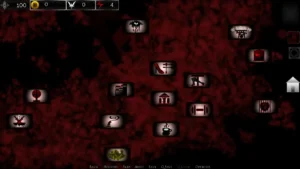
The Void of Deviance
Play The Void of Deviance
The Void of Deviance review
A deep dive into the themes and mechanics of The Void of Deviance
The Void of Deviance is a game that pushes boundaries and invites players into a world where choices shape identity and consequences ripple through every action. With its bold narrative and immersive gameplay, this title has sparked curiosity and conversation among fans of unconventional experiences. In this article, we’ll explore what makes The Void of Deviance unique, from its storytelling to its interactive elements, and why it continues to captivate audiences.
Understanding The Void of Deviance
Have you ever played a game that made you question your own decisions long after you turned off the console? 🤔 I vividly remember my first session with The Void of Deviance—I spent the next hour just staring at the ceiling, replaying a pivotal moral choice in my head. That’s the power of this experience. It’s not just a game; it’s a journey into the depths of human nature and the consequences of our actions. In this chapter, we’re going to unpack what makes The Void of Deviance so compelling, from its haunting narrative to its groundbreaking mechanics. Let’s dive in! 🎮
What is The Void of Deviance?
At its core, The Void of Deviance is an immersive narrative adventure that places you in a crumbling, surreal world where every decision ripples through the fabric of reality. 🌌 I recall starting my playthrough, thinking I’d just enjoy a simple story, but I was quickly pulled into its intricate web. The Void of Deviance story revolves around a protagonist grappling with amnesia, navigating a landscape filled with enigmatic figures and shifting truths. You’re not just playing a character; you’re sculpting their identity through your actions.
The Void of Deviance gameplay is where it truly shines. Instead of relying on combat or complex puzzles, the focus is on dialogue trees and environmental interactions that shape the narrative. For instance, in one early scene, I had to choose whether to trust a shadowy informant or go it alone—a decision that later determined which allies I could recruit. This emphasis on player agency makes every moment feel personal and weighty. The Void of Deviance setting is a dystopian metropolis bleeding into a metaphysical void, a place where societal rules dissolve, and your choices define the chaos or order that emerges. Key Void of Deviance characters include the brooding amnesiac protagonist, a charismatic rebel leader, and a mysterious guide who may not have your best interests at heart. Each interaction with them feels layered, thanks to the game’s deep character development.
Pro Tip: Take your time with dialogues—rushing through can lead to missed nuances that alter the entire Void of Deviance story. I learned this the hard way when a hasty reply locked me out of a whole subplot! 😅
Key Themes in the Game
The Void of Deviance themes are what elevate it from a mere game to a thought-provoking experience. Identity is a central pillar; you’re constantly asked, “Who are you, and what do you stand for?” 🧩 In my playthrough, I faced moments where I had to decide whether to embrace my character’s forgotten past or forge a new identity from scratch. This ties directly into the theme of choice, as every dialogue option and action reflects your values. The Void of Deviance choices aren’t just binary—they’re nuanced, often forcing you to weigh loyalty against survival or truth against comfort.
Consequence is another heavyweight theme. I’ll never forget the time I chose to save a stranger over a longtime ally, only to see that ally’s absence unravel a crucial alliance later. 😢 It drove home the idea that in The Void of Deviance, there are no “right” answers, only ripple effects. The game masterfully weaves these themes into its Void of Deviance gameplay, ensuring that your emotional investment pays off in unexpected ways. For example, a seemingly minor lie I told early on resurfaced hours later, turning a friendly character into a vengeful foe. This depth makes the Void of Deviance characters feel alive and responsive, rather than static NPCs.
- Identity Exploration: Your decisions shape not only the story but who your character becomes.
- Moral Ambiguity: Choices often lack clear good or evil outcomes, mirroring real-life dilemmas.
- Interconnected Consequences: Actions echo throughout the game world, affecting everything from alliances to the environment.
How the Game Challenges Norms
The Void of Deviance doesn’t just follow gaming conventions—it shatters them. 💥 Traditionally, many narrative-driven games offer illusionary choice, where branches eventually converge. But here, your Void of Deviance choices lead to genuinely divergent paths. I was amazed when, after three playthroughs, I discovered entirely new story arcs I hadn’t seen before. This challenges the norm of predictable storytelling and rewards experimentation. The Void of Deviance gameplay also subverts expectations by minimizing hand-holding; instead of quest markers, you rely on environmental cues and character motivations, which makes the world feel more authentic and immersive.
Moreover, the game tackles themes often glossed over in mainstream titles, like the fluidity of morality and the burden of memory. In one powerful case, I had to decide whether to expose a painful truth that would devastate a community or bury it to maintain peace. There was no guide or morality meter—just my gut feeling. 😮 This approach forces players to engage on a deeper level, moving beyond simple “win states” to introspective reflection. For practical advice, I’d suggest embracing the uncertainty; don’t reload saves to “fix” outcomes. Live with your decisions, as that’s where the true emotional weight of the Void of Deviance story lies.
To illustrate how The Void of Deviance stands out, here’s a comparison with other narrative-driven games:
| Feature | The Void of Deviance | Traditional Narrative Games |
|---|---|---|
| Branching Storylines | Extensive, with lasting consequences that reshape the world | Often linear or with limited impact on the core narrative |
| Player Agency | High; choices reflect personal morality and identity | Moderate; choices may influence dialogue but not major plot points |
| Thematic Depth | Explores identity, consequence, and societal deviance in depth | Typically focuses on simpler hero’s journey arcs |
| Character Development | Dynamic, with relationships evolving based on player actions | More static, with predefined character arcs |
This table highlights why The Void of Deviance is a pioneer in its genre. By prioritizing meaningful interaction over spectacle, it invites players to not just consume a story, but to co-author it. 🖊️ Whether you’re a seasoned gamer or new to narrative adventures, this game will leave you pondering long after the credits roll. So, step into the void—your choices await.
The Void of Deviance stands out as a game that dares to explore complex themes through its narrative and gameplay. By challenging norms and inviting players to make meaningful choices, it creates an experience that is both thought-provoking and memorable. If you’re looking for a game that pushes boundaries and offers a unique perspective, The Void of Deviance is definitely worth exploring.






























